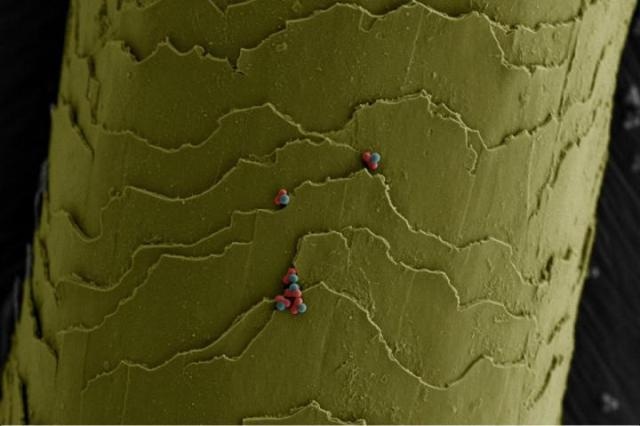Jul 19 2016
 A team of NYU chemists has created malleable and microscopic self-assembling particles that can serve as the next generation of building blocks in the creation of synthetic materials. The research focused on engineering particles a micrometer in width -- about 1/200th the width of a strand of human hair (on which the particles [pink and blue] are placed in the above image). (Photo credit: The Sacanna lab.)
A team of NYU chemists has created malleable and microscopic self-assembling particles that can serve as the next generation of building blocks in the creation of synthetic materials. The research focused on engineering particles a micrometer in width -- about 1/200th the width of a strand of human hair (on which the particles [pink and blue] are placed in the above image). (Photo credit: The Sacanna lab.)
Researchers inspired by a page from Jonathan Swift’s “Gulliver’s Travels”, have developed microscopic and malleable self-assembling particles that can act as advanced building blocks in the formation of synthetic materials.
Our work turns the tiniest of particles from inflexible, Lego-like pieces into ones that can transform themselves into a range of shapes. With the ability to change their contours, these particles mimic alterations that occur in nature.
Stefano Sacanna, Assistant Professor, Department of Chemistry NYU
The paper appears in the journal Nature Communications.
Creating particles measuring a micrometer in width, which is approximately 1/200th the width of a strand of human hair, was the focus of the research.
It is aimed specifically to improve the malleability of colloids, small particles suspended inside a fluid medium. Colloidal dispersions can be found in everyday items such as glass, milk, gelatin, paint, and porcelain, but it is their probability to manipulate flow of light which interests scientists who are focused on developing unique colloidal geometries.
By activating specific morphological changes in the singular colloidal unit, the Sacanna team plan to promote colloidal crystal engineering.
The researchers discovered that similar to Gulliver getting tied down by Lilliputians, metallic particles enclosed in oil droplets were tied up by several chemical bonds.
Using a photocatalytic reaction, where the absorption of light spurs a chemical response, the tethers were broken causing the metallic particle to come free, generating a complete shape change. The researchers were able to develop a material that could transform its microstructure by shining light on a simple crystal.
The co-authors of this research include Mena Youssef and Theodore Hueckel, both NYU doctoral students, and Gi-Ra Yi, a professor at South Korea’s Sungkyunkwan University.
This research was supported by the MRSEC Program of the National Science Foundation (DMR-1420073).